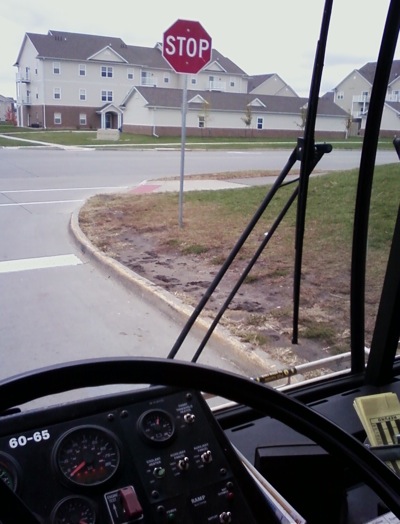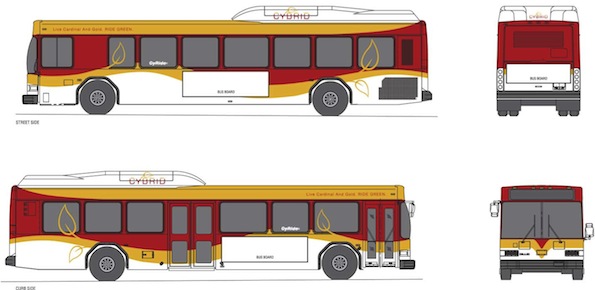The winning “Cybrid” design has been picked for the 10-12 new Gillig hybrids coming soon to CyRide’s bus fleet. Just over 80,000 people voted in an online poll on CyRide’s website to pick from three different designs, with a landslide majority win for the “Gold Leaf” design. CyRide received $1.6 million in 100% federal funding through the 2009 Recovery Act to upgrade diesel buses to hybrid. It has been common for transit systems across the nation to specially brand hybrid buses to promote “going green” and the environmental benefits of riding transit. The first nine Cybrids are scheduled to arrive in Ames by July.
Tag: CyRide

I took this photo on my cellphone a couple weeks ago at the endpoint of Red West. This stop is in front of Ames Middle School, across the street from apartment complexes that house hundreds of college students. For certainly one of the busier bus stops in Ames, you’d think there would be a sidewalk.
CyRide has now published online the timetables for Moonlight Express Alpha (A) Shuttle. Previously the protocol for the late night weekend bus service, would be to call in to base for location and time of the fixed routes A – D. However, not everyone needing the bus on Friday and Saturday nights are drunk and are able to look up the bus schedule themselves. The schedule is only published until about 2am, even though service runs closer to 3am – this allows CyRide to adjust the schedule and service level as needed.
Timetables for Bravo (B) and Delta (D) shuttles, both serving Frederiksen Court, and Charlie (C Shuttle), serving Towers and Billy Sunday, remain unavailable to the public. Bravo and Delta alternate service to Frederiksen, providing continual 18 minute headways between Freddy and Campustown throughout the night. First campus-bound bus departs Freddy at 10:34pm, and then every 18 minutes after until end of service.
The February issue of CyRide’s Signals newsletter includes a list of what they have requested with anticipated transit funding in the national economic stimulus package. A specific wish list has been determined early so once funds are allocated, CyRide will have a chance to get orders in ahead of larger transit agencies, with arrival times for new bus orders typically around 18 months. Included are:
> 10 – 40-foot Heavy-duty Diesel OR Hybrid Electric expansion buses
> 3 – MD Low-floor buses (Full funding to upgrade minibuses 949, 960,961 to MD low-floor buses)
> 3 – MD low-floor bus upgrade (Add funding for 859, 938,939 at MD status as opposed to LD)
> 13 – 40-foot Heavy-duty replacement buses (926, 927, 933, 934, 941, 942, 943, 967, 980, 981, 983, 985, 990)
It is a priority of CyRide to upgrade its fleet and keep up with increasing service demand. However, the garage is basically at capacity and the roof is too low to fit hybrid buses, except for a few newer lanes, part of more recent additions. With no more room to expand on site, a satellite garage is rumored to be CyRide’s next step in facility expansion. It will be interesting to see what happens if all or even part of CyRide’s capital requests are approved and they have addition buses arriving in the next two years.
Additionally, the Ames City Council approved $93,000 from local option sales tax revenue, for city-wide fare free service this summer. The vote passed 4-2, with council members Riad Mahayni and Jami Larson voting no. Mahayni, a former CRP professor of mine, was concerned with the fairness to ISU students who regularly ride for free, but pay for it through student fees. Larson wondered about the consequences of offering a one-time fare free period and the implications when the free service ends in the fall.
Ultimately I think the initiative will get some additional residents on the bus and maybe persuade a few to continue when fares resume. I had not considered the fairness to students issue before, but the opportunity to increase long term ridership and community support is probably worth it. For the summer, CyRide will be unique among Iowa public transit agencies in providing fare free service to all, excluding Cambus which is operated by the University of Iowa and does not extend service beyond campus.
CyRide’s “Rack ‘n ‘Roll” bike rack program officially started this week. The four new Gillig Low Floor buses (units 0819 – 0822) that arrived this summer came equipped with bike racks, and lane workers were adding racks to additional buses last week. The program is only a trial run, but its likely the racks will be here to stay. At this point only about a third of CyRide buses have racks due to space restrictions in the garage that is now at maximum capacity (the racks add one foot of length to each bus). So far I have driven two buses that were retrofitted with racks, but haven’t had any passengers use the racks yet. More information is at cyride.com.
Imagine being able to get around conveniently and timely without ever having to drive a car. This is the general goal of public transportation, however this has hardly been achieved in the United States, thanks to our pro-sprawl, individualistic “American dream.” Public transportation used to thrive in America, with compact cities and streetcar lines in just about every city with a couple thousand or more. But starting with the auto boom in the early 1900s, and then interstate highway construction and suburbanization of the ’50s and ’60s, public transportation declined significantly in the U.S. during the 20th Century.
Today most communities have bus-only systems (see GM streetcar buyout) and operate on subsidies, drawing minimal revenue from passenger fares. Low ridership plagues many systems because most people who can afford a car, drive themselves. This has created a mentality among the public that transit is only for poor and disabled citizens and it is considered a misfortune to have to ride. Truthfully, it is a misfortune since low ridership and sprawling communities make it difficult to provide convenient and efficient service to those who do ride.
Back at school in Ames I began a new part time job in February as a transit driver for CyRide. It is one of the largest bus system in the state of Iowa with a fleet of over 60 buses. Operating in the fairly small city of Ames it is actually quite comprehensive. With no less than half-hourly service and running till midnight or later seven days a week, it is almost comparable to the convenience of driving a car, especially for Iowa State students like myself, who ride for free. Most fixed routes go through campus and circulator routes are operated on school days so it is not unusual to see five to ten buses pass by while walking (or riding) to class. Obviously, most of CyRide’s 4 million plus annual riders are students, but the system benefits city residents alike. Many professors have monthly passes and take CyRide to work regularly.
In contrast to CyRide, Cedar Rapids’ transit system (EAGL) does not provide that same comprehensive service, with less frequent service that ends before 7pm and no service Sunday. Growing up in Cedar Rapids, I very rarely rode the bus and never viewed it as a viable transportation alternative for errands or entertainment. This summer I plan to buy a bus pass and ride Route 3 to and from work. This should allow me better insight into the system and how good or bad it actually is for a regular rider. Look for another post on this in the future.
Image taken from CyRide website.
Links
> CyRide (City of Ames)
> Five Seasons Transportation & Parking (City of Cedar Rapids)
> Wikipedia: Great American Streetcar Scandal
© 2022 URBAN THINKING
Theme by Anders Noren — Up ↑


